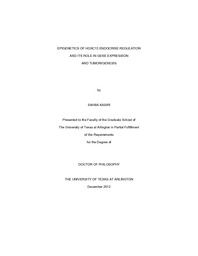| dc.description.abstract | HOX genes are a subgroup of homeobox containing gene superfamily and have crucial roles in cell proliferation, cell differentiation, and embryonic development. HOXC13, one of 39 identified human HOX genes, is involved in hair development and human leukemia. The regulatory mechanism that drives HOXC13 expression is mostly unknown. Our studies demonstrated that HOXC13 is transcriptionally activated by steroid hormone estrogen (17ß-estradiol; E2). The HOXC13 promoter contains several estrogen responsive elements (EREs), including ERE1 and ERE2, which are close to the transcription start site, and are associated with E2-mediated activation of HOXC13. Knockdown of estrogen receptors (ERs) ERɑ and ERß suppressed E2-mediated activation of HOXC13. Similarly, knockdown of mixed lineage leukemia histone methylase (MLL)3 suppressed E2-induced activation of HOXC13. MLLs (MLL1-MLL4) were bound to the HOXC13 promoter in an E2-dependent manner. Knockdown of either ERɑ or ERß affected the E2-dependent binding of MLLs (MLL1-MLL4) into HOXC13 EREs, suggesting critical roles of ERs in recruiting MLLs in the HOXC13 promoter. Overall, our studies have demonstrated that HOXC13 transcriptionally regulated by E2, and MLLs, which, in coordination with ERɑ and ERß, play critical roles in this process. Although MLLs are known to regulate HOX genes, the roles of MLLs in hormone-mediated regulation of HOX genes are unknown. Herein, we demonstrated that MLLs are critical players in E2-dependent regulation of the HOX gene. We also investigated the biochemical functions of HOXC13 and explored its potential roles in tumor cell viability. We have designed a phosphorothioate based antisense oligonucleotide that specifically knockdown HOXC13 in cultured cells. Cell viability and cytotoxicity assays demonstrated that HOXC13 is essential for cell growth and viability. Antisense mediated knockdown of HOXC13 affected the cell viability and induced apoptosis in cultured tumor cells. HOXC13 regulates the expression of cyclins and antisense-mediated knockdown of HOXC13 resulted in cell cycle arrest and apoptosis in colon cancer cells. Intriguingly, application of HOXC13 antisense oligonucleotide suppressed the growth of xenografted colorectal tumor implanted in nude mice.Our further investigations demonstrated that HOXC13 is overexpressed in some cases of breast and colon carcinoma tissues in comparison to their corresponding surrounding normal tissues. We also showed that overexpression of HOXC13 induced the level of tumor growth factors bFGF (basic fibroblast growth factor) and TGFβ1 (transforming growth factor), while HOXC13 knockdown, down regulated these genes. Interestingly, HOXC13 overexpressed cells facilitated 3-D colony formation soft-agar assay while the HOXC13 homeodomain deleted overexpressed cells did not have such ability. This further indicates the potential role of HOXC13 and its homeodomain in cell proliferation and tumorigenesis. | |

